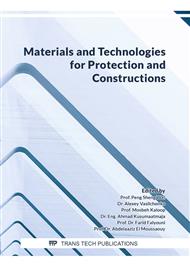[1]
P. Wang, G. Yan, X. Zhu, Y. Du, D. Chen, J. Chang, Heterofullerene MC59 (M = B, Si, Al) as Potential Carriers for Hydroxyurea Drug Delivery, Nanomaterials. 11 (2021) 115.
DOI: 10.3390/nano11010115
Google Scholar
[2]
T.A. Spurlin and A.A. Gewirth, Effect of C60 on solid supported lipid bilayers, Nano Letters. 7(2) (2007) 531-535.
DOI: 10.1021/nl0622707
Google Scholar
[3]
D. Boawan, N. Thomwattana, and J. M. Hill, Encapsulation of C60 fullerenes into single-walled carbon nanotubes: fundamental mechanical principles and conventional applied mathematical modeling, Physical Review B.76 (2007) 8 pages.
DOI: 10.1103/physrevb.76.155411
Google Scholar
[4]
Q. Wang, Torsional instability of carbon nanotubes encapsulating C60 fullerenes, Carbon. 47 (2009) 507–512.
DOI: 10.1016/j.carbon.2008.10.035
Google Scholar
[5]
S. Yang, S. Guo, S. Bai, E. Khosravi, G.L. Zhao, and D. Bagayoko, Doped C60 study from first principles simulation, Journal of Superconductivity and Novel Magnetism. 23 (2010) 877–880.
DOI: 10.1007/s10948-010-0649-4
Google Scholar
[6]
M.D Esrafili, H. Janebi, B-, N-doped and BN codoped C60 heterofullerenes for environmental monitoring of NO and NO2 : a DFT study, Molecular Physics. 118 (2020).
DOI: 10.1080/00268976.2019.1631495
Google Scholar
[7]
F. Sebastianelli, M. Xu, Z. Bacic, R. Rawler, and N.J. Turro, Hydrogen Molecules inside Fullerene C70: Quantum Dynamics, Energetics, Maximum Occupancy, And Comparison with C60. J. Am. Chem. Soc. 132 (2010) 9826 – 9832.
DOI: 10.1021/ja103062g
Google Scholar
[8]
K. Kurotobi, Y. Murata, A Single Molecule of Water Encapsulated in Fullerene C60, Science. 333 (2011) 613.
DOI: 10.1126/science.1206376
Google Scholar
[9]
S. Dhiman, R. Kumar, K. Dharamvir, DFT Study of Cu and Ag Clusters inside C60, Journal of Molecular Structure. 1100 (2015) 328 – 337.
DOI: 10.1016/j.molstruc.2015.07.044
Google Scholar
[10]
M. Medrek, F. Plucinski, A.P. Mazurek, Endohedral Complexes of Fullerene C60 with Small Molecules (H2O, NH3, H2, 2H2, 3H2, 4H2, O2, O3) in the Context of Potential Drug Transporter System, Acta Poloniac Pharmaceutica – Drug Research. 70 (2013) 659 – 665.
Google Scholar
[11]
A. Borowik, Y. Prylutskyy, L. Kawelski, O. Kyzyma, L. Bulavin, O. Ivankov, V. Cherepanov, D. Wyrzykowski, R. Kazmierkiewicz, G. Golunski, A. Woziwodzka, M. Evstigneev, U. Ritter, J. Piosik, Does C60 fullerene act as a transporter of small aromatic molecules?, Colloids and Surfaces B: Biointerfaces. 164 (2018) 134-143.
DOI: 10.1016/j.colsurfb.2018.01.026
Google Scholar
[12]
A. Montellano, T.D. Ros, A. Bianco, M. Prato, Fullerene C60 as a multifunctional system for drug and gene delivery, Nanoscale. 3 (2011) 4035.
DOI: 10.1039/c1nr10783f
Google Scholar
[13]
W. Amalia, P. Nurwantoro, Sholihun, Density-functional-theory calculations of structural and electronic properties of vacancies in monolayer hexagonal boron nitride (h-BN), Computational Condensed Matter. 18 (2019) 18-e00354.
DOI: 10.1016/j.cocom.2018.e00354
Google Scholar
[14]
K. Umam, Sholihun, P. Nurwantoro, A.D. Nugraheni, R.H.S. Budhi, Biaxial strain effects on the electronic properties of silicene: The density-functional-theory-based calculations, Journal of Physics: Conference Series. (2018) 1011(1) 012074.
DOI: 10.1088/1742-6596/1011/1/012074
Google Scholar
[15]
Sholihun, H.P. Kadarisman, P. Nurwantoro, Density-functional-theory calculations of formation energy of the nitrogen-doped diamond, Indonesian Journal of Chemistry. 18(4) (2018) 749–754.
DOI: 10.22146/ijc.26785
Google Scholar
[16]
PHASE, https://azuma.nims.go.jp/cms1.
Google Scholar
[17]
NIST Chemistry Webbook, http://webbook.nist.gov/chemistry.
Google Scholar
[18]
H. Dodziuk, G. Dolgonos, O. Lukin, Molecular mechanics study of endohedral fullerene complexes with small molecules, Carbon. 39 (2001) 1907-1911.
DOI: 10.1016/s0008-6223(00)00323-7
Google Scholar
[19]
T. Korona, H. Dodziuk, Small Molecules in C60 and C70: Which Complexes Could Be Stabilized?, J. Chem. Theory Comput. 7 (2011) 1476–1483.
DOI: 10.1021/ct200111a
Google Scholar
[20]
L. Tsetseris, S.T. Pantelides, Oxygen and water-related impurities in C60 crystals: A density-functional theory study, Physical Review B. 82 (2010).
Google Scholar
[21]
S. Sinthika, E.M. Kumar, V.J. Surya, Y. Kawazoe, N. Park, K. Iyakuti, R. Thapa, Activation of CO and CO2 on homonuclear boron bonds of fullerene-like BN cages: first principles study, Scientific Reports. 5 (2015) 17460.
DOI: 10.1038/srep17460
Google Scholar



